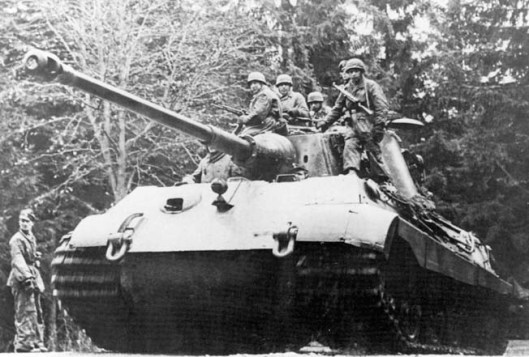
For purposes of this offensive, Hitler created the Sixth SS Panzer Army[1], consisting of four Panzer divisions under the command of Josef A. “Sepp” Dietrich, an SS officer both fierce and trusted. From the northern Ardennes in the vicinity of Monschau, Dietrich would lead the Schwerpunkt (principal thrust) of a classic Blitzkrieg offensive.
The offensive included an airborne assault, which the Germans had not used since the very earliest days of the war, and a special unit, the 150th SS Brigade under Otto Skorzeny, the brilliant special forces commander who had successfully pulled off the rescue of overthrown Italian dictator Benito Mussolini. The paratroops were to secure and hold key Meuse bridges in order to facilitate the German advance after it had broken through the Allied lines, and Skorzeny’s command, which included English-speaking troops dressed in American uniforms and driving American vehicles, was to infiltrate and disrupt the American rear area. Unfortunately for the Germans, the airborne drops were poorly executed, the troops landing too widely dispersed to carry out their mission against the bridges. While Skorzeny’s forces did cause significant confusion, they achieved little of tactical significance, and soldiers captured in American uniforms were summarily executed. Nevertheless, the very tip of Dietrich’s 1st SS Panzer Division, Col. Joachim Peiper’s armored Kampfgruppe, made an early lightning thrust deep into American-held territory, through Malmédy, Belgium, west of which it was finally destroyed.
6.Panzer-Armee
LXVII. Armeekorps
– 272. Volks-Grenadier-Division
– 326. Volks-Grenadier-Division
I.SS-Panzerkorps
– 277. Volks-Grenadier-Division
– 12. Volks-Grenadier-Division
– 3.Fallschirm-Jäger-Division
– 12. SS-Panzer-Division HJ
– 1.SS-Panzer-Division LSSAH
II.SS-Panzerkorps
– 2.SS-Panzer-Division DR
– 9.SS-Panzer-Division HH
Assault units
– StuG-Brigade 394
– StuG-Brigade 667
– Stu.Pz.-Abteilung 217
– Pz.Jg.-Abteilung (mot.Z) 683
Artillery
– Volks-Artillerie-Korps 402
– Volks-Artillerie-Korps 388
– Volks-Artillerie-Korps 405
– Volks-Werfer-Brigade 9
– Volks-Werfer-Brigade 4
– Volks-Werfer-Brigade 17
– Mörser-Batterie 1110
– Mörser-Batterie 1098
– Mörser-Batterie 1120
– Mörser-Batterie 428
Engineers
– Pionier-Batallion 73
– Pionier-Batallion 253
– Pionier-Batallion 62
– Pionier-Brück.Batallion 655
– Baupionier-Batallion 798
– Baupionier-Batallion 59
– Brüko 602
– Brüko 2/406
– Brüko 1/403
– Brüko 967
– Brüko 968
– Brüko 895
– Brüko 844
– Brüko 851
– Brüko 175
Units assigned later
– s.Panzer-Abteilung 506
– s.Panzer-Abteilung (Fkl) 301
– Panzerjäger-Abteilung 519
Since September, perceiving the Allies had overextended themselves, Hitler had been considering risking a counter-offensive, codenamed Wacht am Rhein. If German forces could repeat their feat of 1940, forcing their way through the Allied lines in the Ardennes and then up to Antwerp, he would strike a blow that would, he hoped, buy time, allowing the V2s to wreak destruction on London and Paris. It was an unrealistic notion, and opposed by Model and Rundstedt, but Hitler’s control over German strategy was still complete. He marshalled all his remaining reserves for what was now called Operation Autumn Mist, believing that a victory would enable him to transfer them to the east while the Soviets were still a distance from Berlin. Initially, conditions worked in his favour. Allied forces were recuperating after the dash through France, Market-Garden and the long fight in the Huertgen Forest and Scheldt Estuary. Exhaustion combined with a certain complacency at Allied Supreme Headquarters. The fog that descended on the Ardennes gave perfect cover for the concentration of the panzers in the narrow forest roads and valleys and negated Allied air superiority.
On 16 December 25 divisions (11 panzer) in three armies overran resting or recently arrived US units on a 60-mile (95 km) front. The advance of Manteuffel’s 5th Panzer Army in the centre went smoothly, backed by Dietrich in the north, Brandenburger in the south and Operation Greif – German infiltration units in American uniforms – in the Meuse region. The Germans were held at key points, however, by the courage and resilience of detached and isolated American units, particularly the 101st Airborne, rapidly deployed from Rheims to Bastogne, and 7th Armored at St Vith, and including non-combatant personnel such as cooks. Bastogne was the key to the roads leading into the Allied rear and the delay there proved crucial. Time was gained to reorganise and deploy 200,000 troops to hold the breakthrough and for the weather to improve sufficiently for the fighter-bombers to operate. German failure to capture fuel dumps meant their shortage of petrol stopped the drive short of the Meuse. Patton turned the front-line units of 3rd Army through 90 degrees across their line of march, to strike at the German flank from the south, and Montgomery, given command of US troops by Eisenhower, more conventionally struck with the 1st Army from the north. The bulge into the Allied line was steadily reduced and by early January Hitler ordered withdrawal. It had been the largest American land battle in the war, and had removed any complacency about an early end to the war. It meant the Yalta Conference would take place in February with a conviction on both sides that the Grand Alliance was still a necessity as the job was by no means completed. It also, however, depleted the last of the German armoured and aircraft reserves in the west and diverted attention away from strengthening the West Wall, so that once the Allies had forced a way across the Rhine, there would be little to prevent a rapid advance into the Ruhr industrial area and the tanks and aircraft squandered in the Bulge were desperately needed against the Soviets in the east.
[1] The 6th Panzer Army is best noted for its leading role in the Battle of the Bulge (December 16, 1944 – January 25, 1945). On April 2, 1945, it was transferred to the Waffen-SS. The 6th Panzer Army then became known as 6th SS Panzer Army (6. SS-Panzerarmee).